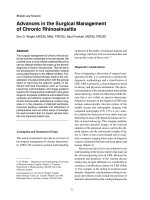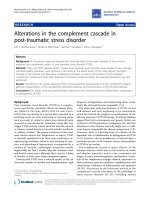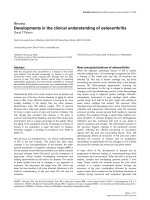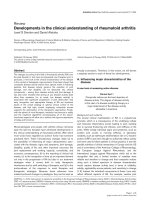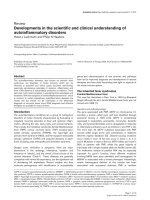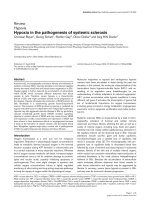Báo cáo y học: "Probiotics in the intensive care unit: why controversies and confusion abound" doc
Bạn đang xem bản rút gọn của tài liệu. Xem và tải ngay bản đầy đủ của tài liệu tại đây (44.75 KB, 2 trang )
Page 1 of 2
(page number not for citation purposes)
Available online />Abstract
Probiotics are living microorganisms that, when administered in
adequate amounts, confer health benefits on the host. Because
probiotics are not marketed as pharmaceuticals, they are
commercially available without rigorous scientific documentation of
their efficacy for many health-related claims. Results from existing
clinical trials are both confusing and controversial. The evidence
base is relatively limited, includes studies with varied designs,
assesses multiple probiotic preparations across discrepant
disease states, and provides conflicting results. Recent advances
in the delineation of probiotics’ mechanisms of action offer the
opportunity to construct a more logical framework within which
future trials are designed.
In this era of increasing antimicrobial resistance and limited
activity in the antibiotic pipeline, novel nonantibiotic strategies
for prevention of nosocomial infections are of particularly
intense interest. The current issue of Critical Care brings us
the findings of Forestier and colleagues [1], who demon-
strated that oral administration of a probiotic Lactobacillus
preparation delayed respiratory tract colonization with
Pseudomonas aeruginosa. This delay in colonization resulted
in a reduced rate of ventilator-associated pneumonia caused
by P. aeruginosa in the probiotic-treated patients.
The Food and Agriculture Organization of the United Nations
(FAO) and the World Health Organization (WHO) currently
endorse guidelines defining probiotics as live microorganisms
that, when administered in adequate amounts, confer a health
benefit on the host [2]. Because probiotics are commercially
marketed as dietary supplements or complementary and
alternative medicine products, they are not subjected to the
same rigorous review by the US Food and Drug Adminis-
tration as conventional pharmaceutical products or devices.
As a result, the scientific documentation of many probiotic-
related health claims is lacking. At present, peer-reviewed
data from randomized, double-blind, placebo-controlled
clinical trials support the efficacy of probiotics for treating and
preventing acute diarrhea and antibiotic-induced diarrhea and
for preventing cow milk-induced food allergies. Less rigorous
data suggest efficacy in traveler’s diarrhea, relapsing
Clostridium difficile-induced colitis, and urinary tract infec-
tions. Other areas of investigation include dental carries,
respiratory infections, irritable bowel syndrome, inflammatory
bowel disease, and asthma [3].
Although proponents of probiotics will herald the results of
the study by Forestier and colleagues [1] as the latest in a
long series of studies confirming that probiotics are beneficial
across an array of illnesses, critics will note that there are
multiple studies showing a lack of efficacy with these agents.
More troubling, one recent multi-center, randomized, placebo-
controlled study showed increased mortality in pancreatitis
patients given a novel probiotic preparation [4]. The mortality
difference in this study was driven primarily by between group
differences in bowel ischemia—not infectious complications of
the probiotic—and lacks a mechanism that is clearly
attributable to the administration of the probiotic. The
controversy surrounding probiotics will likely grow as ongoing
trials using probiotics in ventilator-associated pneumonia are
nearing completion and the results will soon be publicly
reported.
Much of the current confusion surrounding the efficacy of
probiotics results from differences in study designs, discre-
pant study populations, and inconsistencies specific to the
probiotic, including the strain used (dose administered,
Commentary
Probiotics in the intensive care unit: why controversies and
confusion abound
Lee E Morrow
1
and Marin H Kollef
2
1
Pulmonary, Critical Care and Sleep Medicine, Creighton University Medical Center, 601 North 30th Street, Suite #3820, Omaha, NE 68131, USA
2
Pulmonary and Critical Care Medicine, Washington University, Barnes-Jewish Hospital, 660 South Euclid Avenue, Campus Box 8052, St Louis,
MO 63110, USA
Corresponding author: Lee E Morrow,
Published: 24 June 2008 Critical Care 2008, 12:160 (doi:10.1186/cc6927)
This article is online at />© 2008 BioMed Central Ltd
See related research by Forestier et al., />FAO = Food and Agriculture Organization of the United Nations; GI = gastrointestinal; TLR = Toll-like receptor; WHO = World Health Organiza-
tion.
Page 2 of 2
(page number not for citation purposes)
Critical Care Vol 12 No 3 Morrow and Kollef
product formulation, and route of administration). These
disparate results also stem from the fact that we currently
have the cart in front of the horse: we have pursued multiple
avenues of clinical investigations with probiotics despite our
lack of insight regarding these agents’ mechanisms of action.
In line with the FAO/WHO definition, probiotics were
originally thought to provide benefit by repopulating the gut
with ‘friendly flora’ that essentially over-grew potentially
pathogenic organisms. This theory fell out of favor when it
was demonstrated that the beneficial effects of probiotics
were seen without measurable changes in host flora and
often persisted beyond the window of colonization. Subse-
quent theories of probiotics’ mechanism of action focused on
enhancement of barrier function and local antibacterial
effects [5-7]. Although both of these mechanisms clearly
exist, neither accounts for the observation that ingestion of
nonviable probiotics or injection of probiotic derivatives offers
similar benefit to ingestion of living organisms [8].
The theory that best explains probiotics’ mechanism of action
is immunomodulation resulting from crosstalk between the
gastrointestinal (GI) probiotic elements, the GI mucosa, and
underlying mucosal lymphoid elements [9]. This theory is
extrapolated from the observation that commensal bacteria
within the gut lumen interact with Toll-like receptor-2 (TLR-2)
and TLR-4 on the appendages extended from dendritic cells
within the lamina propria [10]. This interaction stimulates
dendritic cell maturation and the production of cytokines that
drive naïve T-helper cells (Th0) to mature into balanced Th1,
Th2, and Th3/Tr1 helper subsets [11]. Such interactions
between commensals and dendritic cells also activate plasma
cells, resulting in IgA-producing cells [12,13]. Commensal
organisms additionally interact with TLR-9, thereby producing
an anti-inflammatory cytokine milieu rich in interleukin-10 [14].
In aggregate, these cellular mechanisms provide intestinal
host defense mechanisms and regulate both local and
systemic inflammation. Using probiotics to ensure adequate
bacterial colonization has been demonstrated to maintain this
balanced immune response [15].
It is currently unknown whether there are optimal probiotic
species, doses, and/or formulations. Another area of particular
clinical interest is whether combination therapy is superior to
single-agent therapy. The recent findings of the Dutch Acute
Pancreatitis Study Group mandate that we also evaluate the
ideal route(s) of probiotic administration [4]. Eventually, it may
be possible to pair individual probiotic organisms with
specific disease states or desired goals. However, it is also
increasingly evident that a comprehensive understanding of
probiotics’ mechanisms of action will be the key element in
resolving these multiple controversies. We should not lose
sight of this goal as increased knowledge regarding our
ability to modulate the systemic immune system also promises
novel therapeutic targets and therapeutic agents. Such under-
standing will also help us to avoid further trials demonstrating
increased mortality in probiotic-treated patients.
Competing interests
The authors declare that they have no competing interests.
References
1. Forestier C, Guelon D, Cluytens V, Gillart T, Sirot J, De Champs
C: Oral probiotic and prevention of Pseudomonas aeruginosa
infections: a randomized, double-blind, placebo-controlled
pilot study in intensive care unit patients. Crit Care 2008, 12:
R69.
2. Joint FAO/WHO Working Group: Guidelines for the evaluation
of probiotics in food: report of a joint FAO/WHO working
group on drafting guidelines for the evaluation of probiotics in
food. London, ON, Canada; 2002 [ />fs_management/en/probiotic_guidelines.pdf].
3. Goldin BR, Gorbach SL: Clinical indications for probiotics: an
overview. Clin Infect Dis 2008, 46:S96-100.
4. Besselink MG, van Santvoort HC, Buskens E, Boermeester MA,
van Goor H, Timmerman HM, Nieuwenhuijs VB, Bollen TL, van
Ramshorst B, Witteman BJ, Rosman C, Ploeg RJ, Brink MA,
Schaapherder AF, Dejong CH, Wahab PJ, van Laarhoven CJ, van
der Harst E, van Eijck CH, Cuesta MA, Akkermans LM, Gooszen
HG; Dutch Acute Pancreatitis Study Group: Probiotic prophy-
laxis in predicted severe acute pancreatitis: a randomized,
double-blind, placebo-controlled trial. Lancet 2008, 371:651-
659.
5. Resta-Lenert S, Barrett KE: Live probiotics protect intestinal
epithelial cells from the effects of infection with enteroinva-
sive Escherichia coli (EIEC). Gut 2003, 52:988-997.
6. Boudeau J, Glasser AL, Julien S, Colombel JF, Darfeuille-Michaud
A: Inhibitory effect of probiotic Escherichia coli strain Nissle
1917 on adhesion to and invasion of intestinal epithelial cells
by adherent-invasive E. coli strains isolated from patients with
Crohn’s disease. Aliment Pharmacol Ther 2003, 18:45-56.
7. Flynn S, van Sinderen D, Thornton GM, Holo H, Nes IF, Collins JK:
Characterization of the genetic locus responsible for the pro-
duction of ABP-118, a novel bacteriocin produced by the pro-
biotic bacterium Lactobacillus salivarius subsp. salivarius
UCC118. Microbiology 2002, 148:973-984.
8. Sheil B, McCarthy J, O’Mahony L, Bennett MW, Ryan P, Fitzgib-
bon JJ, Kiely B, Collins JK, Shanahan F: Is the mucosal route of
administration essential for probiotic function? Subcutaneous
administration is associated with attenuation of murine colitis
and arthritis. Gut 2004, 53:694-700.
9. Shi HN, Walker WA: Bacterial colonization and the develop-
ment of intestinal defenses. Can J Gastroenterol 2004, 18:493-
500.
10. Rescigno M, Urbano M, Valzasina B, Francolini M, Rotta G,
Bonasio R, Granucci F, Kraehenbuhl JP, Ricciardi-Castagnoli P:
Dendritic cells express tight junction proteins and penetrate
gut epithelial monolayers to sample bacteria. Nat Immunol
2001, 2:361-367.
11. Christenson HR, Frokiaer H, Pestka JJ: Lactobacilli differentially
modulate expression of cytokines and maturation surface
markers in murine dendritic cells. J Immunol 2002, 168:171-
178.
12. Macpherson AJ, Uhr T: Induction of protective IgA by intestinal
dendritic cells carrying commensal bacteria. Science 2004,
303:1662-1665.
13. Qamar A, Aboudola A, Warny M, Michetti P, Pothoulakis C,
LaMont JT, Kelly CP: Saccharomyces boulardii stimulates
intestinal immunoglobulin A immune response to Clostridium
difficile toxin A in mice. Infect Immun 2001, 69:2762-2765.
14. Otte JM, Podolsky DK: Functional modulation of enterocytes by
gram-positive and gram-negative microorganisms. Am J
Physiol Gastrointest Liver Physiol 2004, 286:G613-626.
15. Kalliomaki MA, Walker WA: Physiologic and pathologic interac-
tions of bacteria with gastrointestinal epithelium. Gastroen-
terol Clin North Am 2005, 34:383-399.



